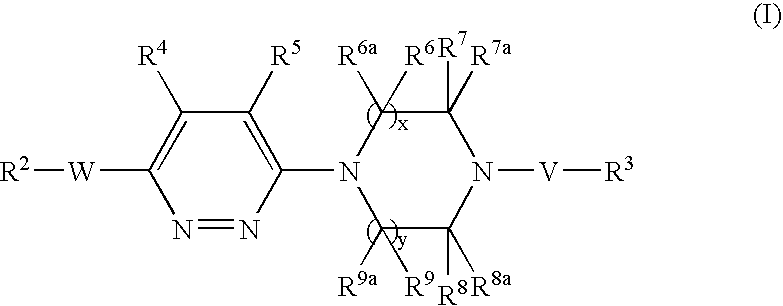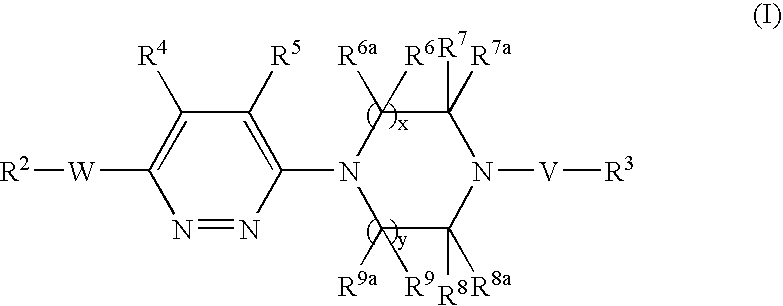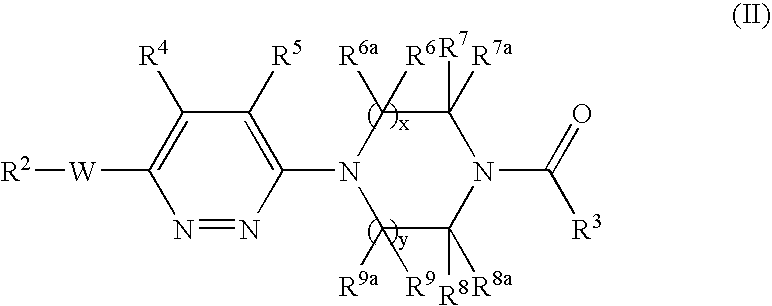Pyridazine derivatives and their use as therapeutic agents
a technology of pyridazine and desaturase, which is applied in the direction of drug composition, extracellular fluid disorder, metabolic disorder, etc., can solve the problems that the known modulator of delta-9 desaturase activity is not useful in treating diseases and disorders linked to scd1 biological activity, and achieves effective modulation of triglyceride level, reduced lipid level, and elevated lipid level
- Summary
- Abstract
- Description
- Claims
- Application Information
AI Technical Summary
Benefits of technology
Problems solved by technology
Method used
Image
Examples
preparation 1
Synthesis of 2-CYCLOPROPYLETHYLAMINE
Concentrated sulfuric acid (20.66 mL) was added dropwise to a vigorously stirred suspension of lithium aluminum hydride (764.4 mmol) in 800 mL of anhydrous ethyl ether (40 mL) at 0° C. for at least 2 hour period. The reaction mixture was warmed to ambient temperature and stirred for 1 hour, and a solution of cyclopropylacetonitrile (246.5 mmol) in 100 mL of anhydrous ethyl ether was added dropwise. The resulting mixture was heated to reflux for 2 hours, then cooled to 0° C., cautiously quenched with crushed ice. A solution of 38 g of NaOH in 350 mL of water was added, and the organic layer was decanted from the resulting aluminum hydroxide precipitate. The precipitate was washed thoroughly with ethyl ether (3×600 mL). All ethereal extracts were combined, dried over anhydrous Na2SO4 and the solvent was distilled off to afford 172.5 mmol of 2-cyclopropylethylamine as a colorless liquid (bp ˜100-108° C.). Yield 70%.
preparation 2
Synthesis of 6-CHLOROPYRIDAZINE-3-CARBOXYLIC Acid
To a mechanically stirred solution of 3-chloro-6-methylpyridazine (155.6 mmol) in 140 mL of concentrated sulfuric acid, finely powdered potassium dichromate (55.40 g) was added slowly, the temperature being kept below 50° C. When the addition was complete, stirring was continued for another 4 hours at 50° C. The viscous, dark green liquid was then cooled and crushed ice was added cautiously. The reaction mixture was extracted with ethyl acetate (6×400 mL). The ethyl acetate extracts were combined, dried over anhydrous Na2SO4. The solvent was concentrated in vacuo to yield slightly red colored 6-chloropyridazine-3-carboxylic acid (106.6 mmol). This material was used for next reaction without further purification. Yield 69%. m.p. 145° C. (dec). 1H NMR (300 MHz, DMSO-d6) δ 13.1, 8.20, 8.05.
preparation 3
Synthesis of 6-CHLOROPYRIDAZINE-3-CARBOXYLIC Acid (2-CYCLOPROPYLETHYL)AMIDE
To a solution of 6-chloropyridazine-3-carboxylic acid (15.8 mmol) in dichloromethane (95 mL) was added diisopropylethylamine (46.7 mmol), 1-hydroxybenzotriazole monohydrate (23.7 mmol) and 1-(3-dimethylaminopropyl)-3-ethylcarbodiimide (23.7 mmol) under nitrogen atmosphere at ambient temperature. The resulting mixture was stirred for 15 minutes and 2-cyclopropylethylamine (20.2 mmol) was added. After stirring for 36 hours at ambient temperature, the reaction mixture was diluted with dichloromethane (100 mL), then washed with water and dried over anhydrous Na2SO4. The solvent was removed in vacuo. Purification via column chromatography (30% ethyl acetate in hexanes) afforded the title compound (8.70 mmol). Yield 55%.
PUM
| Property | Measurement | Unit |
|---|---|---|
| Composition | aaaaa | aaaaa |
Abstract
Description
Claims
Application Information
 Login to View More
Login to View More - R&D
- Intellectual Property
- Life Sciences
- Materials
- Tech Scout
- Unparalleled Data Quality
- Higher Quality Content
- 60% Fewer Hallucinations
Browse by: Latest US Patents, China's latest patents, Technical Efficacy Thesaurus, Application Domain, Technology Topic, Popular Technical Reports.
© 2025 PatSnap. All rights reserved.Legal|Privacy policy|Modern Slavery Act Transparency Statement|Sitemap|About US| Contact US: help@patsnap.com



